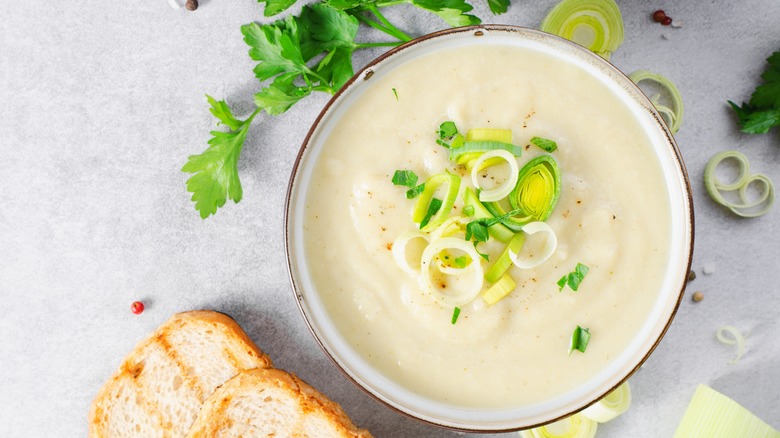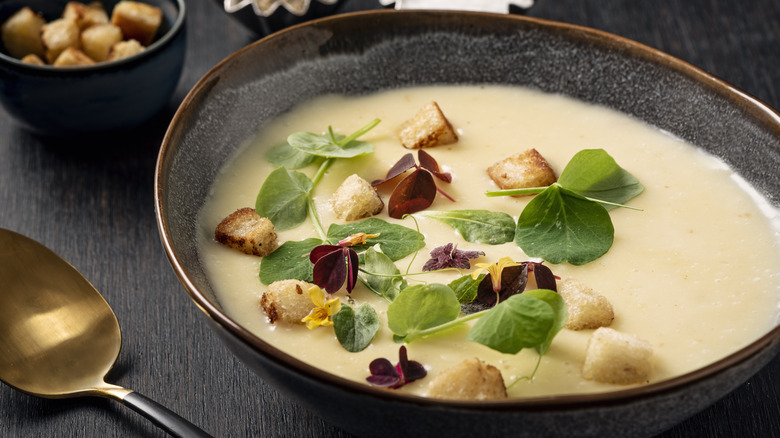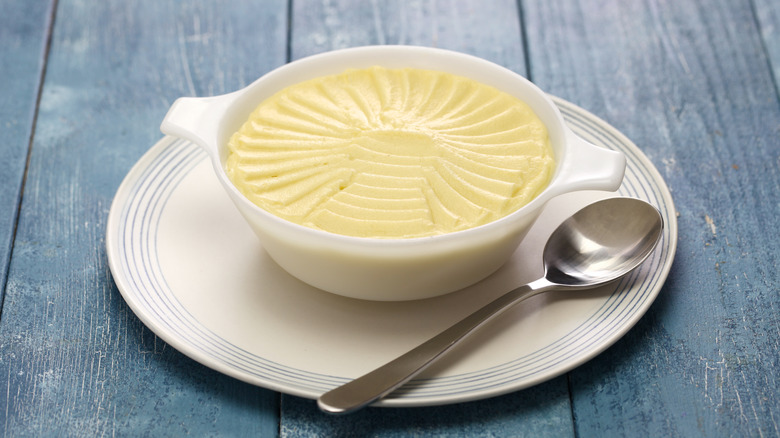Puréed Potatoes Are A Must-Try Cream Substitute For Soups
It could be due to an allergy, a preference, or just a downright dislike, but not everyone loves cream. Yet, it seems to have wormed its way into many classical soup recipes, and it's tricky to find a truly life-like substitute. Leek and potato, cream of mushroom, broccoli and cheese, and even chicken soup recipes will more likely than not contain cream. You may already know some cream substitutes — such as coconut milk — however, adding this to soups can completely alter the flavor dynamics. The replacement you're looking for that won't ruin all those delicate tastes is puréed potato.
Potatoes can save an overly salty soup, and they can save a creamless one too. Potato purée, or pomme purée, is not overly-mushed mashed potato; it is more refined. It takes a degree of care to reach a smooth consistency, quite unlike the brash beating you give your potatoes when creating mash. To mimic cream perfect for soups, it all comes down to what potatoes you use, the fat you add, and the patience you must embody. With these in check, your soup will reflect that classical creamy version you want to recreate.
No cream in sight
One way to add puréed potatoes to soup is to cook the potatoes with all the other ingredients. When the soup is almost ready, carefully remove the potatoes from the pot and blitz them in a blender before stirring them back into the soup mix. This method might resemble fishing at one stage, which is where it is slightly tedious. To avoid this scenario — and really cultivate the most velvety purée imaginable — create the potato purée separate from the other soup ingredients.
To prepare the potato purée, blitz soft-boiled potatoes in a food processor and add fat to this mixture. Butter and milk work nicely and can easily be substituted with plant-based versions to avoid dairy altogether. This mixture can then be added to the soup base when ready. For a silky smooth texture, grab a medium-mesh strainer and press the soup (with the added potato purée) through the strainer using a spatula. Then reheat and season to taste. This is also a great way to create a consistent texture among all the ingredients used in the soup. Potato purée doesn't necessarily have to replace cream, as it's a fantastic way to bulk up a thin soup base too.
The path to the ultimate puréed potato
To begin, making the ultimate potato purée comes down to every significant detail, including the type of potato used. Use a waxy potato like Yukon Gold, as these will hold the added fats better, creating a more creamy consistency overall. Using other potato varieties could result in a less than satisfactory purée. Instead of peeling the potatoes as you would with mash, boiling them with the skin on will prevent their flesh from absorbing a lot of water. Thus resulting in a creamier, less watery purée. You can then remove their skins by pushing them through a tamis (a type of flour sieve).
Your pomme purée should not resemble the liquid-like texture of cream; it will be slightly thicker. Blending the potato in a food processor will give you flexibility on how thin you want it to be. A mouli or potato ricer are other tools you can use to create a smooth potato purée, but they will not provide the same versatility of puréeing that a blender will.
Luckily, creamy dishes do not have to contain cream, and using puréed potatoes in a soup can create the same effect without the heaviness. Whether you're searching for the crème-de-la-crème of potato purée or you fancy experimenting with smooth potato instead of cream, this is something that will undoubtedly enhance your soup.


